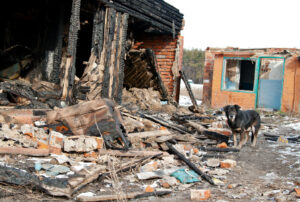How to Keep Your Pets Safe in a Disaster

Watching the evacuations and rescues of Hurricane Harvey on TV, it’s easy to judge. It’s easy to say, “Shoulda, coulda, woulda.” We all want to believe we are prepared for a disaster, but the reality is that most of us are not. And maybe we can’t be ready for every possible scenario. But we can be ready for the most likely ones and can prepare in advance both with training and a disaster-preparedness pack for ourselves and our pets.
In the event of an emergency, is your animal able to be in an unfamiliar situation and not panic? Sometimes we don’t know the answer to this question until it happens, but there is training that can help keep your pets safe in a time of crisis.
Crate Training. Some people crate-train their pets. This is a valuable lesson for any dog or cat. Even if your pet does not sleep or spend time in a crate at home, he may need to in an emergency. If you are displaced from your home and must find shelter, emergency personnel may need to crate your animal. This will likely be a scary time for your pet anyway, but if you have trained him to feel safe in a crate, the experience could be less frightening. Even if not an emergency, there are times in your pet’s life when a vet may need to crate him, and it is helpful to your animal if he does not feel fearful of the crate when so many other frightening things are happening.
Muzzle Training. This is a good skill for any dog. A muzzle ensures a dog’s safety as well as the safety of others. During a disaster, when you need to leave your home, you want to be able to take your dog with you. Strangers may be grabbing at him to help him, and he may inadvertently bite out of fear at the hand that is helping. If he is already comfortable wearing a muzzle, you can know that if emergency personnel handle him, he and they will be safe. Even a dog who “would never bite” might do so in the hectic and confusing time of an emergency. You don’t want your pet to be left behind because he bit out of fear. Note: I prefer the Baskerville muzzle above all others, because it allows for the dog to pant, take treats, and drink water.
So, you now have a little bit of training to help your animals in a crisis. But what about the physical items you need to bring with you? Just as we can pack ourselves an emergency bag, we can do so for our pets, as well!
What to Include in your Disaster-Preparedness Pet Pack
- Canned food with can opener
- Kibble or freeze-dried food
- Water
- Food bowls
- Harness and leash
- Medications/Supplements
- Medical records, Vaccination records, and Vet’s phone number in a waterproof container
- Lost Dog or Lost Cat flyer with photos and contact info ready to go – also in waterproof container
- Towel
- Blanket
- Poop bags
- Muzzle
- Toys
- First Aid for Pets book
- First Aid Kit with items like:
- gauze
- gloves
- space blanket
- styptic powder
- wraps
- scissors
- antibiotic ointment
- cold and hot compresses
- tweezers
- vet wrap
- saline eye wash
- antibiotic flush for wounds
Things move fast during a disaster and we don’t have time to think of a list of the many items we need. Help yourself and your animals by creating that list now, when you can focus. Get yourself a First Aid book, make a Disaster-Preparedness Pack (for both you and your pets!), and do some training. And don’t forget to have your pets microchipped (and registered!) and have a good photo of them on your phone. You will be less likely to say “shoulda, coulda, woulda” and instead be able to say, “I’m so glad I did.”
Lynn Webb, M.A., KPA CTP, CTMT


